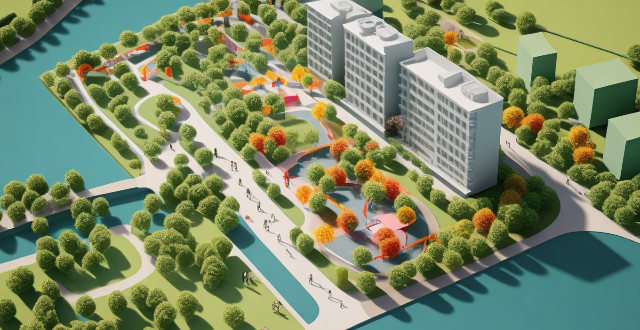Sports culture has a significant impact on urban planning and infrastructure development, promoting accessibility, connectivity, land use planning, facility development, technology adoption, and innovation. It encourages the creation of parks and open spaces, mixed-use developments, and pedestrian-friendly environments. Sports venues require efficient transportation networks and public services such as emergency response systems and waste management facilities. The construction of sports facilities drives the development of hotels, restaurants, retail stores, and other hospitality services. Technology and innovation are also influenced by sports culture, with smart city technologies, sustainable design principles, energy efficiency measures, digital engagement tools, and data analytics being increasingly incorporated into sports facilities. As cities continue to embrace sports culture as an integral part of their identity, they must prioritize these factors when designing and implementing urban plans to create vibrant, healthy communities that benefit both residents and visitors alike.

Impact of Sports Culture on Urban Planning and Infrastructure Development
Introduction
Sports culture refers to the values, beliefs, customs, and practices associated with sports and physical activities in a community or society. It plays a significant role in shaping the urban environment by influencing the way cities are planned and infrastructure is developed. This article will discuss the impact of sports culture on urban planning and infrastructure development, focusing on its positive effects.
The Importance of Sports Culture
- Health and Wellness: Sports culture promotes physical activity, which is essential for maintaining good health and wellbeing. Engaging in sports reduces the risk of chronic diseases such as obesity, diabetes, and heart disease.
- Community Building: Sports bring people together and create a sense of community. They provide opportunities for social interaction and foster a sense of belonging among residents.
- Economic Benefits: Sports events and facilities attract tourists and generate revenue for local businesses. They also create job opportunities in various sectors such as hospitality, transportation, and retail.
- Urban Renewal: Sports facilities can act as catalysts for urban renewal projects, transforming neglected areas into vibrant spaces that attract investment and revitalize neighborhoods.
Impact on Urban Planning
Accessibility and Connectivity
- Transportation Networks: Sports venues require efficient transportation networks to accommodate large crowds during events. This leads to improvements in public transit systems, including bus routes, subway lines, and bike lanes.
- Pedestrian Access: Pedestrian-friendly environments are crucial for promoting active lifestyles. Cities may invest in sidewalks, crosswalks, and pedestrian bridges to ensure safe access to sports facilities.
- Green Spaces: Sports culture encourages the creation of parks and open spaces where people can engage in recreational activities. These green spaces contribute to overall city aesthetics and improve air quality.
Land Use Planning
- Mixed-Use Development: Integrating sports facilities into mixed-use developments can enhance livability by providing residents with easy access to fitness centers, swimming pools, and other recreational amenities.
- Zoning Regulations: Cities may implement zoning regulations to ensure that sports facilities are located near residential areas, making it easier for residents to participate in physical activities regularly.
- Historic Preservation: Sports culture can also influence the preservation of historic buildings and landmarks by incorporating them into new sports complexes or using them as venues for sporting events.
Impact on Infrastructure Development
Facilities and Infrastructure
- Sports Venues: Cities may construct stadiums, arenas, and sports complexes to host major sporting events and attract tourism dollars.
- Public Services: Sports culture drives the development of public services such as emergency response systems, waste management facilities, and utility networks to support large crowds during events.
- Recreational Facilities: Parks, playgrounds, and other recreational facilities are built to encourage physical activity among residents of all ages.
- Accommodation and Hospitality: Hotels, restaurants, and other hospitality services often develop around sports venues to cater to visitors attending games or tournaments.
- Commercial Development: Retail stores, shopping centers, and entertainment venues may be constructed near sports facilities to capitalize on increased foot traffic from fans and tourists.
Technology and Innovation
- Smart City Technologies: Sports culture can drive the adoption of smart city technologies such as mobile apps for ticketing, parking, and wayfinding; Wi-Fi connectivity; and advanced security systems.
- Sustainable Design: Green building practices and sustainable design principles are increasingly incorporated into the construction of sports facilities to minimize environmental impact and reduce operating costs.
- Energy Efficiency: Energy-efficient lighting systems, solar panels, and other renewable energy sources are integrated into sports facilities to reduce energy consumption and carbon footprint.
- Digital Engagement: Virtual reality experiences, interactive displays, and social media integration can enhance fan engagement and create unique experiences for visitors.
- Data Analytics: Data analytics tools are used to optimize facility operations, improve customer service, and enhance safety measures at sports venues.
Conclusion
Sports culture has a profound impact on urban planning and infrastructure development by promoting accessibility, connectivity, land use planning, facility development, technology adoption, and innovation. As cities continue to embrace sports culture as an integral part of their identity, they must prioritize these factors when designing and implementing urban plans to create vibrant, healthy communities that benefit both residents and visitors alike.